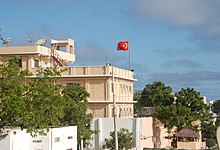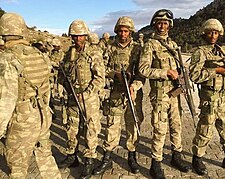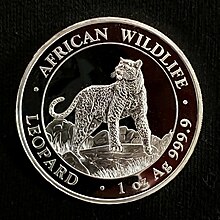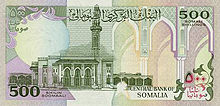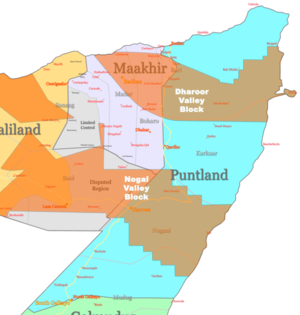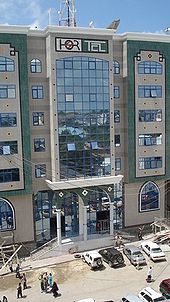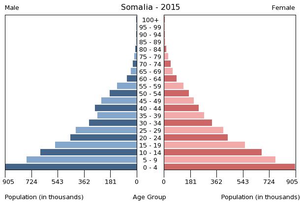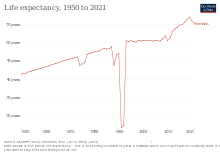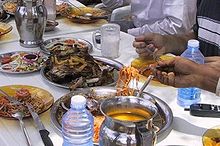Somalia
Federal Republic of Somalia Jamhuuriyadda Federaalka Soomaaliya ( Arabic )Jumhūriyah aṣ-Ṣūmāl al-Fīdirāliyah | ||
|---|---|---|
| Anthem: |
| |
| Religion | Speaker of the House | Aden Madobe |
| Legislature | House of the People | |
| Independence from Italy | ||
| 1889 | ||
• Independence and union with the State of Somaliland | 1 July 1960 | |
| 1 August 2012 | ||
| Area | ||
• Total | 637,657[1] km2 (246,201 sq mi) (43rd) | |
| Population | ||
• 2023 estimate | 17,597,511[3] (78th) | |
• Density | 27.2[4]/km2 (70.4/sq mi) (199th) | |
| GDP (PPP) | 2023 estimate | |
• Total | ||
• Per capita | ||
| GDP (nominal) | 2023 estimate | |
• Total | ||
• Per capita | ||
| HDI (2022) | low (193rd) | |
| Currency | Somali shilling (SOS) | |
| Time zone | UTC+3 (EAT) | |
| Driving side | right | |
| Calling code | +252 | |
| ISO 3166 code | SO | |
| Internet TLD | .so | |
Somalia,[a] officially the Federal Republic of Somalia,[b] is the easternmost country in continental Africa. The country is on the Horn of Africa and is bordered by Ethiopia to the west, Djibouti[11] to the northwest, the Gulf of Aden to the north, the Indian Ocean to the east, and Kenya to the southwest. Somalia has the longest coastline on Africa's mainland.[12] In antiquity, Somalia was an important commercial center.[13][14] During the Middle Ages, several powerful Somali empires dominated the regional trade, including the Ajuran Sultanate, Adal Sultanate, Imamate of Awsame, and the Sultanate of the Geledi. In the late 19th century, Somali sultanates were colonized by the Italian and British Empires,[15][16][17] who merged all of these tribal territories into two colonies: Italian Somaliland and British Somaliland.[18][19] In 1960, the two territories united to form the independent Somali Republic under a civilian government.[20] Siad Barre of the Supreme Revolutionary Council (SRC) seized power in 1969 and established the Somali Democratic Republic, brutally attempting to squash the Somaliland War of Independence in the north of the country.[21] The SRC collapsed in 1991 with the onset of the Somali Civil War.[22] The Transitional National Government of Somalia (TNG) was established in 2000, followed by the formation of the Transitional Federal Government of Somalia (TFG) in 2004, which reestablished the Somali Armed Forces.[1][23]
In 2006, with a US-backed Ethiopian intervention, the TFG assumed control of most of the nation's southern conflict zones from the newly formed Islamic Courts Union (ICU). The ICU subsequently splintered into more radical groups, including the jihadist group al-Shabaab, which battled the TFG and its AMISOM allies for control of the region.[1] By mid-2012, the insurgents had lost most of the territory they had seized, and a search for more permanent democratic institutions began.[24] Despite this, insurgents still control much of central and southern Somalia,[25][26] and wield influence in government-controlled areas,[26] with the town of Jilib acting as the de facto capital for the insurgents.[25][27] A new provisional constitution was passed in August 2012,[28][29] reforming Somalia as a federation.[30] The same month, the Federal Government of Somalia was formed[31] and a period of reconstruction began in Mogadishu, despite al-Shabaab frequently carrying out attacks there.[24][32]
Somalia has an estimated population of around 17.1 million,[33][34] of which over 2 million live in the capital and largest city Mogadishu. It has been described as Africa's most culturally homogeneous country.[35][36] Around 85% of its residents are ethnic Somalis.[1] Ethnic minorities are largely concentrated in the south.[37] The official languages of Somalia are Somali and Arabic,[1] though the former is the primary language. Most people in Somalia are Muslims,[38] the majority of them being Sunni.[39] Somalia is among the least developed countries in the world, as evidenced by its ranking in metrics such as GDP per capita,[40] Human Development Index,[41] and the Fragile States Index.[42] It has maintained an informal economy mainly based on livestock, remittances from Somalis working abroad, and telecommunications.[43] It is a member of the United Nations,[44] the Arab League,[45] African Union,[46] Non-Aligned Movement,[47] East African Community,[48] and the Organisation of Islamic Cooperation.[49]
History
Prehistory

Somalia was likely one of the first lands to be settled by early humans due to its location. Hunter-gatherers who would later migrate out of Africa likely settled here before their migrations.[50] During the Stone Age, the Doian and Hargeisan cultures flourished here.[51][52][53][50][54][55] The oldest evidence of burial customs in the Horn of Africa comes from cemeteries in Somalia dating back to the 4th millennium BCE.[56] The stone implements from the Jalelo site in the north were also characterized in 1909 as important artifacts demonstrating the archaeological universality during the Paleolithic between the East and the West.[57]
According to linguists, the first
The Laas Geel complex on the outskirts of Hargeisa in northwestern Somalia dates back approximately 5,000 years, and has rock art depicting both wild animals and decorated cows.[60] Other cave paintings are found in the northern Dhambalin region, which feature one of the earliest known depictions of a hunter on horseback. The rock art is dated to 1,000 to 3,000 BCE.[61][62] Additionally, between the towns of Las Khorey and El Ayo in northern Somalia lies Karinhegane, the site of numerous cave paintings, which collectively have been estimated to be around 2,500 years old.[63][64]
Antiquity and classical era
Ancient
In the
During the classical period, the

After the
Birth of Islam and the Middle Ages

Throughout the Middle Ages, Arab immigrants arrived in Somaliland, a historical experience which would later lead to the legendary stories about Muslim
In 1332, the Zeila-based King of Adal was slain in a military campaign aimed at halting Abyssinian emperor
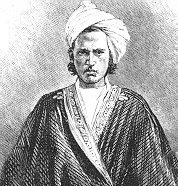
Adal's headquarters were again relocated the following century, this time southward to
During the
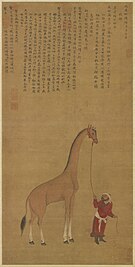
In the 16th century,
Trading relations were established with
Early modern era and the scramble for Africa

In the
Sultan Yusuf Mahamud Ibrahim, the third Sultan of the House of Gobroon, started the golden age of the Gobroon Dynasty. His army came out victorious during the Bardheere Jihad, which restored stability in the region and revitalized the East African ivory trade. He also had cordial relations and received gifts from the rulers of neighbouring and distant kingdoms such as the Omani, Witu and Yemeni Sultans.
Sultan Ibrahim's son
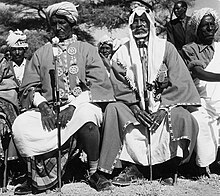
In Somalland, the Isaaq Sultanate was established in 1750. The Isaaq Sultanate was a Somali kingdom that ruled parts of the Horn of Africa during the 18th and 19th centuries.[97] It spanned the territories of the Isaaq clan, descendants of the Banu Hashim clan,[99] in modern-day Somaliland and Ethiopia. The sultanate was governed by the Rer Guled branch established by the first sultan, Sultan Guled Abdi, of the Eidagale clan.[100][101][102] According to oral tradition, prior to the Guled dynasty the Isaaq clan-family were ruled by a dynasty of the Tolje'lo branch starting from, descendants of Ahmed nicknamed Tol Je'lo, the eldest son of Sheikh Ishaaq's Harari wife. There were eight Tolje'lo rulers in total, starting with Boqor Harun (Somali: Boqor Haaruun) who ruled the Isaaq Sultanate for centuries starting from the 13th century.[103][104] The last Tolje'lo ruler Garad Dhuh Barar (Somali: Dhuux Baraar) was overthrown by a coalition of Isaaq clans. The once strong Tolje'lo clan were scattered and took refuge amongst the Habr Awal with whom they still mostly live.[105][106]
In the late 19th century, after the

The Dervish movement successfully repulsed the British Empire four times and forced it to retreat to the coastal region.[110] The Darawiish defeated the Italian, British, Abyssinian colonial powers on numerous occasions, most notably, the 1903 victory at Cagaarweyne commanded by Suleiman Aden Galaydh,[111] forcing the British Empire to retreat to the coastal region in the late 1900s.[112] The Dervishes were finally defeated in 1920 by British airpower.[113]
The dawn of
A British force, including troops from several African countries, launched the
Independence (1960–1969)
Following World War II, Britain retained control of both
Britain included the conditional provision that the Somali residents would retain their autonomy, but Ethiopia immediately claimed sovereignty over the area. This prompted an unsuccessful bid by Britain in 1956 to buy back the Somali lands it had turned over.
A
The majority of those who voted 'no' were Somalis who were strongly in favour of joining a united Somalia, as had been proposed by Mahmoud Harbi, Vice President of the Government Council. Harbi was killed in a plane crash two years later.[124] Djibouti finally gained independence from France in 1977, and Hassan Gouled Aptidon, a Somali who had campaigned for a 'yes' vote in the referendum of 1976, eventually became Djibouti's first president (1977–1999).[124]

On 1 July 1960, five days after the former British Somaliland protectorate obtained independence as the State of Somaliland, the territory united with the Trust Territory of Somaliland to form the
On 15 October 1969, while paying a visit to the northern town of
Somali Democratic Republic (1969–1991)

Alongside Barre, the Supreme Revolutionary Council (SRC) that assumed power after President Sharmarke's assassination was led by Brigadier General Mohamed Ainanshe Guled, Lieutenant Colonel Salaad Gabeyre Kediye and Chief of Police Jama Korshel. Kediye officially held the title "Father of the Revolution", and Barre shortly afterwards became the head of the SRC.[131] The SRC subsequently renamed the country the Somali Democratic Republic,[132][133] dissolved the parliament and the Supreme Court, and suspended the constitution.[134]
The revolutionary army established large-scale public works programs and successfully implemented an urban and rural literacy campaign, which helped dramatically increase the literacy rate. In addition to a nationalization program of industry and land, the new regime's foreign policy placed an emphasis on Somalia's traditional and religious links with the Arab world, eventually joining the Arab League in February, 1974.[135] That same year, Barre also served as chairman of the Organisation of African Unity (OAU), the predecessor of the African Union (AU).[136]
In July 1976, Barre's SRC disbanded itself and established in its place the Somali Revolutionary Socialist Party (SRSP), a one-party government based on scientific socialism and Islamic tenets. The SRSP was an attempt to reconcile the official state ideology with the official state religion by adapting Marxist precepts to local circumstances. Emphasis was placed on the Muslim principles of social progress, equality and justice, which the government argued formed the core of scientific socialism and its own accent on self-sufficiency, public participation and popular control, as well as direct ownership of the means of production. While the SRSP encouraged private investment on a limited scale, the administration's overall direction was essentially communist.[134]
In July 1977, the
A new constitution was promulgated in 1979 under which elections for a People's Assembly were held. However, Barre's Somali Revolutionary Socialist Party politburo continued to rule.[133] In October 1980, the SRSP was disbanded, and the Supreme Revolutionary Council was re-established in its place.[134]
The regime was weakened further in the 1980s as the Cold War drew to a close and Somalia's strategic importance was diminished. The government became increasingly
Somalia Civil War
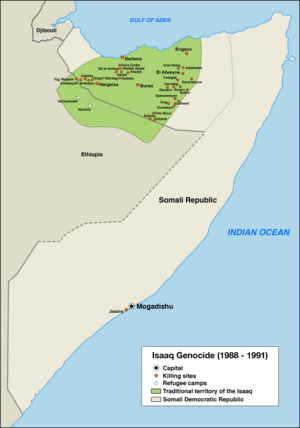
As the moral authority of Barre's government was gradually eroded, many Somalis became disillusioned with life under military rule. By the mid-1980s, resistance movements supported by Ethiopia's communist Derg administration had sprung up across the country. Barre responded by ordering punitive measures against those he perceived as locally supporting the guerrillas, especially in the northern regions. The clampdown included bombing of cities, with the northwestern administrative centre of Hargeisa, a Somali National Movement (SNM) stronghold, among the targeted areas in 1988.[139][140]
The clampdown initiated by Barre's government extended its reach beyond the initial bombings in the north to encompass various regions across the country. This reproduction of aggressive strategies aimed at stifling descent and retaining authority over the populace was a hallmark of the government's repressive actions in the South. One of the most notable instances occurred in 1991, when Barre's regime initiated a ruthless arial assault that led to the deaths of numerous innocent individuals in the town of Beledwene, situated in southern Somalia.[141] The cruelty and magnitude of this atrocity highlighted the degree to which the government was prepared to go to quash any sort of opposition or resistance, displaying a blatant disregard for human rights and the worth of human life.[142]
Another notable instance of Barre's repressive policies occurred in the city of Baidoa, which earned the nickname 'the city of death' due to the tragic events that unfolded there during the famine and civil war.[143] It is worth noting that hundreds of thousands of individuals lost their lives as a consequence of governmental strategies specifically aimed at the Rahanweyn community residing in these areas.[144]
During 1990, in the capital city of Mogadishu, the residents were prohibited from gathering publicly in groups greater than three or four. Fuel shortages, inflation, and currency devaluation impacted the economy. A thriving black market existed in the centre of the city as banks experienced shortages of local currency for exchange. Harsh
In 1991, the Barre administration was ousted by a coalition of clan-based opposition groups, backed by Ethiopia's then-ruling
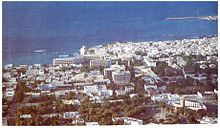
Many of the opposition groups subsequently began competing for influence in the power vacuum that followed the ouster of Barre's regime. In the south, armed factions led by USC commanders General
In the early 1990s, due to the protracted lack of a permanent central authority, Somalia began to be characterized as a "failed state".[153][154][155]
Transitional institutions
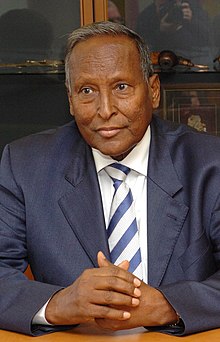
The Transitional National Government (TNG) was established in April–May 2000 at the Somalia National Peace Conference (SNPC) held in Arta, Djibouti. Abdiqasim Salad Hassan was selected as the President of the nation's new Transitional National Government (TNG), an interim administration formed to guide Somalia to its third permanent republican government.[156] The TNG's internal problems led to the replacement of the Prime Minister four times in three years, and the administrative body's reported bankruptcy in December 2003. Its mandate ended at the same time.[157]
On 10 October 2004, legislators elected
The Transitional Federal Government (TFG) was the internationally recognised government of Somalia until 20 August 2012, when its tenure officially ended.
Islamic Courts Union
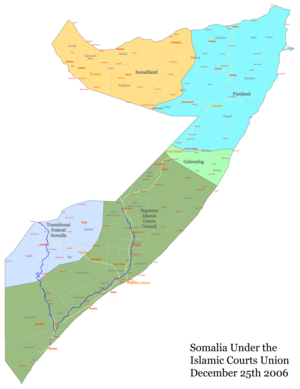
In 2006, the
Transitional Federal Government
The Transitional Federal Government sought to re-establish its authority, and, with the assistance of Ethiopian troops, African Union peacekeepers and air support by the United States, drove out the ICU and solidified its rule.[162] On 8 January 2007, TFG President Abdullahi Yusuf Ahmed entered Mogadishu with the Ethiopian military support for the first time since being elected to office. The government then relocated to Villa Somalia in the capital from its interim location in Baidoa. This marked the first time since the fall of the Siad Barre regime in 1991 that the federal government controlled most of the country.[163]
Al Shabaab insurgency
Owing to a lack of funding and human resources, an arms embargo that made it difficult to re-establish a national security force, and general indifference on the part of the international community, Yusuf found himself obliged to deploy thousands of troops from Puntland to Mogadishu to sustain the battle against insurgent elements in the southern part of the country. Financial support for this effort was provided by the autonomous region's government. This left little revenue for Puntland's own security forces and civil service employees, leaving the territory vulnerable to piracy and terrorist attacks.[165][166]
On 29 December 2008, Yusuf announced before a united parliament in Baidoa his resignation as President of Somalia. In his speech, which was broadcast on national radio, Yusuf expressed regret at failing to end the country's seventeen-year conflict as his government had been mandated to do.[167] He also blamed the international community for their failure to support the government, and said that the speaker of parliament would succeed him in office per the Charter of the Transitional Federal Government.[168]
End of transitional period
Between 31 May and 9 June 2008, representatives of Somalia's federal government and the Alliance for the Re-liberation of Somalia (ARS) participated in peace talks in Djibouti brokered by the former United Nations Special Envoy to Somalia,

With the help of a small team of African Union troops, the TFG began a
In October 2011, a coordinated operation,

As part of the official "Roadmap for the End of Transition", a political process that provided clear benchmarks leading toward the formation of permanent democratic institutions in Somalia, the Transitional Federal Government's interim mandate ended on 20 August 2012.[24] The Federal Parliament of Somalia was concurrently inaugurated.[31]
Federal government
The Federal Government of Somalia, the first permanent central government in the country since the start of the civil war, was established in August 2012. In August 2014, the Somali government-led Operation Indian Ocean was launched against insurgent-held pockets in the countryside.[176]
Geography
Somalia is bordered by Ethiopia to the west, the Gulf of Aden to the north, the Somali Sea and Guardafui Channel to the east, and Kenya to the southwest. With a land area of 637,657 square kilometers, Somalia's terrain consists mainly of plateaus, plains and highlands.[177] Its coastline is more than 3,333 kilometers in length, the longest of mainland Africa.[12] It has been described as being roughly shaped "like a tilted number seven".[178]
In the far north, the rugged east–west ranges of the Ogo Mountains lie at varying distances from the Gulf of Aden coast. Hot conditions prevail year-round, along with periodic monsoon winds and irregular rainfall.[179] Geology suggests the presence of valuable mineral deposits. Somalia is separated from Seychelles by the Somali Sea and is separated from Socotra by the Guardafui Channel.
Administrative divisions
Somalia is officially divided into eighteen regions (gobollada, singular gobol),[1] which in turn are subdivided into districts. The regions are:
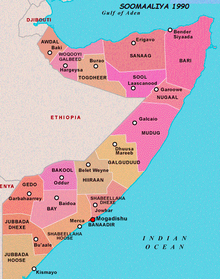
| Region | Area (km2) | Population[180][181] | Capital |
|---|---|---|---|
| Awdal | 21,374 | 1,010,566 | Borama |
| Bari | 70,088 | 949,693 | Bosaso |
| Nugal | 26,180 | 473,940 | Garowe
|
| Mudug | 72,933 | 864,728 | Galkayo |
| Galguduud | 46,126 | 634,309 | Dusmareb |
| Hiran | 31,510 | 566,431 | Beledweyne |
| Middle Shabelle | 22,663 | 622,660 | Jowhar |
| Banaadir | 370 | 2,330,708 | Mogadishu |
| Lower Shabelle | 25,285 | 1,218,733 | Barawa |
| Togdheer | 38,663 | 962,439 | Burao |
| Bakool | 26,962 | 383,360 | Xuddur
|
Woqooyi Galbeed
|
28,836 | 1,744,367 | Hargeisa |
| Bay | 35,156 | 1,035,904 | Baidoa |
| Gedo | 60,389 | 566,318 | Garbahaarreey
|
| Middle Juba | 9,836 | 432,248 | Bu'aale
|
| Lower Juba | 42,876 | 632,924 | Kismayo |
| Sanaag | 53,374 | 578,092 | Erigavo |
Sool
|
25,036 | 618,619 | Las Anod |
Northern Somalia is now de facto divided up among the
The Federal Parliament is tasked with selecting the ultimate number and boundaries of the autonomous regional states (officially Federal Member States) within the Federal Republic of Somalia.[184][185]
Location

Somalia is bordered by Kenya to the southwest, the
Waters
Somalia has the longest coastline on the mainland of Africa,[187] with a seaboard that stretches 3,333 kilometres (2,071 mi). Its terrain consists mainly of plateaus, plains and highlands. The nation has a total area of 637,657 square kilometres (246,201 sq mi) of which constitutes land, with 10,320 square kilometres (3,980 sq mi) of water. Somalia's land boundaries extend to about 2,340 kilometres (1,450 mi); 58 kilometres (36 mi) of that is shared with Djibouti, 682 kilometres (424 mi) with Kenya, and 1,626 kilometres (1,010 mi) with Ethiopia. Its maritime claims include territorial waters of 200 nautical miles (370 km; 230 mi).[1]
Somalia has several islands and archipelagos on its coast, including the

Habitat
Somalia contains seven terrestrial ecoregions:
In the north, a scrub-covered, semi-desert plain referred as the
Somalia has only two permanent rivers, the Jubba and Shabele, both of which begin in the Ethiopian Highlands. These rivers mainly flow southwards, with the Jubba River entering the Indian Ocean at Kismayo. The Shabele River at one time apparently used to enter the sea near Merca, but now reaches a point just southwest of Mogadishu. After that, it consists of swamps and dry reaches before finally disappearing in the desert terrain east of Jilib, near the Jubba River.[186]
Environment

Somalia is a

Later,
Following the massive
The European Green Party followed up these revelations by presenting before the press and the European Parliament in Strasbourg copies of contracts signed by two European companies — the Italian Swiss firm, Achair Partners, and an Italian waste broker, Progresso — and representatives of the then President of Somalia, the faction leader Ali Mahdi Mohamed, to accept 10 million tonnes of toxic waste in exchange for $80 million (then about £60 million).[195]
According to reports by the
Climate

Owing to Somalia's proximity to the equator, there is not much seasonal variation in its climate. Hot conditions prevail year-round along with periodic monsoon winds and irregular rainfall. Mean daily maximum temperatures range from 30 to 40 °C (86 to 104 °F), except at higher elevations along the eastern seaboard, where the effects of a cold offshore current can be felt. In Mogadishu, for instance, average afternoon highs range from 28 to 32 °C (82 to 90 °F) in April. Some of the highest mean annual temperatures in the world have been recorded in the country; Berbera on the northwestern coast has an afternoon high that averages more than 38 °C (100 °F) from June through September. Nationally, mean daily minimums usually vary from about 15 to 30 °C (59 to 86 °F).[186] The greatest range in climate occurs in northern Somalia, where temperatures sometimes surpass 45 °C (113 °F) in July on the littoral plains and drop below the freezing point during December in the highlands.[179][186] In this region, relative humidity ranges from about 40% in the mid-afternoon to 85% at night, changing somewhat according to the season.[186] Unlike the climates of most other countries at this latitude, conditions in Somalia range from arid in the northeastern and central regions to semiarid in the northwest and south. In the northeast, annual rainfall is less than 100 mm (4 in); in the central plateaus, it is about 200 to 300 mm (8 to 12 in). The northwestern and southwestern parts of the nation, however, receive considerably more rain, with an average of 510 to 610 mm (20 to 24 in) falling per year. Although the coastal regions are hot and humid throughout the year, the hinterland is typically dry and hot.[186]
There are four main seasons around which pastoral and agricultural life revolve, and these are dictated by shifts in the wind patterns. From December to March is the Jilal, the harshest dry season of the year. The main rainy season, referred to as the Gu, lasts from April to June. This period is characterized by the southwest monsoons, which rejuvenate the pasture land, especially the central plateau, and briefly transform the desert into lush vegetation. From July to September is the second dry season, the Xagaa (pronounced "Hagaa"). The Dayr, which is the shortest rainy season, lasts from October to December.[186] The tangambili periods that intervene between the two monsoons (October–November and March–May) are hot and humid.[186]
Wildlife

Somalia contains a variety of mammals due to its geographical and climatic diversity. Wildlife still occurring includes
Somalia is home to around 727 species of birds. Of these, eight are endemic, one has been introduced by humans, and one is rare or accidental. Fourteen species are globally threatened. Birds species found exclusively in the country include the
Somalia's territorial waters are prime fishing grounds for highly migratory marine species, such as tuna. A narrow but productive continental shelf contains several
There are roughly 235 species of reptiles. Of these, almost half live in the northern areas. Reptiles endemic to Somalia include the Hughes'





